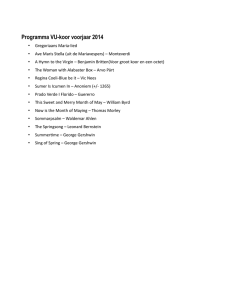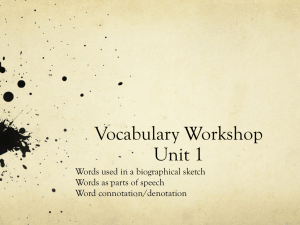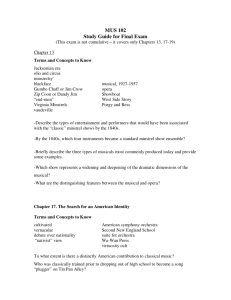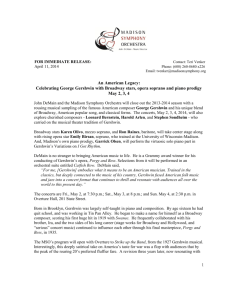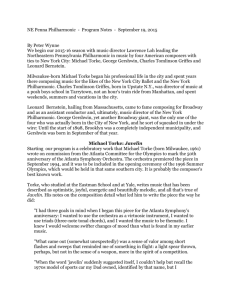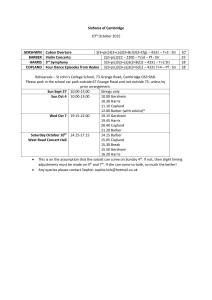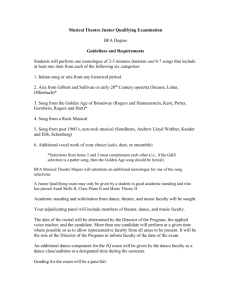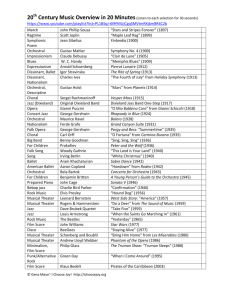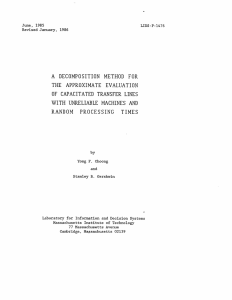Mar 17, 2002 The Glory of Gershwin
advertisement
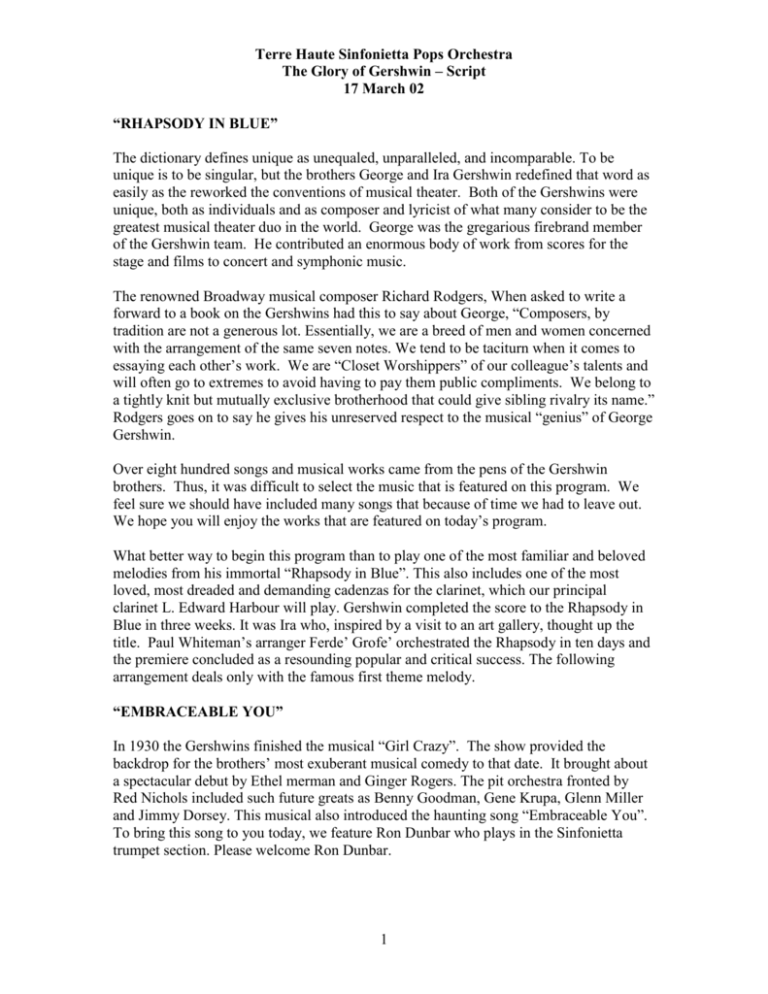
Terre Haute Sinfonietta Pops Orchestra The Glory of Gershwin – Script 17 March 02 “RHAPSODY IN BLUE” The dictionary defines unique as unequaled, unparalleled, and incomparable. To be unique is to be singular, but the brothers George and Ira Gershwin redefined that word as easily as the reworked the conventions of musical theater. Both of the Gershwins were unique, both as individuals and as composer and lyricist of what many consider to be the greatest musical theater duo in the world. George was the gregarious firebrand member of the Gershwin team. He contributed an enormous body of work from scores for the stage and films to concert and symphonic music. The renowned Broadway musical composer Richard Rodgers, When asked to write a forward to a book on the Gershwins had this to say about George, “Composers, by tradition are not a generous lot. Essentially, we are a breed of men and women concerned with the arrangement of the same seven notes. We tend to be taciturn when it comes to essaying each other’s work. We are “Closet Worshippers” of our colleague’s talents and will often go to extremes to avoid having to pay them public compliments. We belong to a tightly knit but mutually exclusive brotherhood that could give sibling rivalry its name.” Rodgers goes on to say he gives his unreserved respect to the musical “genius” of George Gershwin. Over eight hundred songs and musical works came from the pens of the Gershwin brothers. Thus, it was difficult to select the music that is featured on this program. We feel sure we should have included many songs that because of time we had to leave out. We hope you will enjoy the works that are featured on today’s program. What better way to begin this program than to play one of the most familiar and beloved melodies from his immortal “Rhapsody in Blue”. This also includes one of the most loved, most dreaded and demanding cadenzas for the clarinet, which our principal clarinet L. Edward Harbour will play. Gershwin completed the score to the Rhapsody in Blue in three weeks. It was Ira who, inspired by a visit to an art gallery, thought up the title. Paul Whiteman’s arranger Ferde’ Grofe’ orchestrated the Rhapsody in ten days and the premiere concluded as a resounding popular and critical success. The following arrangement deals only with the famous first theme melody. “EMBRACEABLE YOU” In 1930 the Gershwins finished the musical “Girl Crazy”. The show provided the backdrop for the brothers’ most exuberant musical comedy to that date. It brought about a spectacular debut by Ethel merman and Ginger Rogers. The pit orchestra fronted by Red Nichols included such future greats as Benny Goodman, Gene Krupa, Glenn Miller and Jimmy Dorsey. This musical also introduced the haunting song “Embraceable You”. To bring this song to you today, we feature Ron Dunbar who plays in the Sinfonietta trumpet section. Please welcome Ron Dunbar. 1 Terre Haute Sinfonietta Pops Orchestra The Glory of Gershwin – Script 17 March 02 “THE MAN I LOVE” Out of the musical “Lady be Good” in 1924 came the memorable song “The Man I Love”. Interestingly, this song did not achieve immediate popularity. George himself said, “This tune as written did not quite click. Soon I realized that the verse was better than the chorus. So I discarded the chorus. In went the verse as the chorus and I wrote another verse to fit the new chorus and my brother set the words”. Again the melody met with scant initial success. The song was soon performed by all the dance bands in London, Paris, and America. After considerable success in this format, “The Man I Love” was sung in New York by Helen Morgan, who was almost single handedly responsible for its American success. To sing this song for you today, we are delighted to have Miss Martha Jordan back from our last concert. Please welcome Martha Jordan. “THEY CAN’T TAKE THAT AWAY FROM ME” George and Ira were already a hit on Broadway when they moved to Hollywood in 1930. Some might have thought it was a step down for them, but they certainly raised the level of the movie musical. Hollywood was at first worried that the Gershwins would be too “long hair” for the film industry. However, the movie moguls were eventually convinced that the team could turn out commercial tunes again. The film “Shall we Dance” came out in 1937 featuring Fred Astaire and Ginger Rogers and included ballet, tap, and ballroom dancing. One of the songs that was introduced in this film was “They Can’t Take That Away From Me”. The Sinfonietta Brass will perform this piece for you. Please welcome the Sinfonietta Brass. “SOMEONE TO WATCH OVER ME” One of the immortal hits from the musical “Oh Kay” was “Someone to Watch Over Me”. This musical starred Gertrude Lawrence who captivated New York. In the second act of “Oh Kay”, the glamorous singer had the stage to herself to sing this song. On opening night, Miss Lawrence sang the song to a doll in her arms. George had suggested that she use it in the number. To sing this for you we have brought you our own doll, sixteen year alias Thompson has won several awards for the singing of this melody in her young career. We are most pleased to feature Miss Alisa Thompson. “SUMMERTIME” Gershwin said of Jazz, “I regard this music as an American Folk Music’ not the only one, but very a powerful one which is probably in the blood and feeling of the American people more than any other style of music. I believe that it can be made the basis of serious symphonic works of lasting value”. With this in mind, Gershwin made a serious effort on a large scale when he wrote “Porgy and Bess” in 1935. This opera was based on the play, “Porgy” by Debose Heyward and produced by the New York Theatre Guild. 2 Terre Haute Sinfonietta Pops Orchestra The Glory of Gershwin – Script 17 March 02 Many memorable melodies came from this work, some of which you will hear later in this program. But now, the haunting tune called “Summertime” is worthy to be featured alone in an arrangement by Chuck Sayre. INTERMISSION “AN AMERICAN IN PARIS” It was known in the music world that George was writing “An American in Paris”. Some people thought it was commissioned by Flo Ziegfield as a ballet for one of his musicals. Others thought he was writing it for producer Ray “Goetz. Conductor Loepold Stokowski wanted to conduct the premiere of the work with the Philadelphia Orchestra. When Gershwin offered it to Walter Damrosch and the New York Philharmonic however, Stokowski bowed out of the picture. “An American in Paris” was given its premiere performance at Carnegie Hall, December 15th, 1928. When listening to this composition, imagine an American visiting Paris, walking down the Champs-Elysees, on a mild sunny morning in May of June. Our American’s ears being open, as well as our eyes, he notes with pleasure the sounds of the city. French taxicabs are heard…then our American passes the open door of a café where the trombones are heard. Soon it is apparent that our hero has met a compatriot, which is announced by the trumpets. The orchestra proceeds to demonstrate that it is always fair weather when tow Americans get together, no matter where. The Orchestra in the finale decides to make a night of it; it will be great to get home, but meanwhile, this is Paris. “GERSHWIN IN CONCERT” In our next number, you will hear a medley of familiar Gershwin melodies. It is entitled “Gershwin in Concert”. The medley includes, “I Got Rhythm”, Someone to Watch Over Me”, S’Wonderful, and Rhapsody in Blue”. As a special treat, the song, “I Got Rhythm” will be danced by a chorus line from the Teresa Miles School of Dance. Please enjoy these lovely dancers. “STRIKE UP THE BAND” In 1926, George and Ira joined with George S. Kaufman in creating a satire that would lash out at the futilities of international politics, the League of Nations, and War itself. “Strike up the Band” opened in Long Branch, New Jersey in August of 1927. A few days later, when the show opened in Philadelphia, one music critic called it, “A rollicking show, a veritable geyser of spontaneous comedy, a thoroughly refreshing departure from routine”. The Teresa Miles School of Dance has again created a special dance to this melody. Please welcome the Teresa Miles School of Dance chorus line. 3 Terre Haute Sinfonietta Pops Orchestra The Glory of Gershwin – Script 17 March 02 “SWANEE” At the height of the great Al Jolson’s stage career in 1927, the invention of talking motion pictures brought Jolson both a technical challenge, and a chance to further capture more fans. Warner Bros. featured him in the first full length film with dialogue, “The Jazz Singer”. He scored a tremendous success in this first screen vehicle while marking a new chapter in the history of entertainment. One night, Jolson gave a midnight party after a show with Gershwin in attendance. George played a new song entitled, “Swanee”. Jolson at once adopted it and introduced it within three or four days, and the rest is history. Jolson made Swanee a hit, the biggest hit song Gershwin ever had. On stage, Jolson captured the hearts of America with a familiar choice of words. LISTEN, you can still hear those words –(Ronn, at this point, Buzz Burgess will stand up in the trombone section and shout) –“FOLK’S, YOU AIN’T HEARD NOTHIN YET”! Conductor will start and the orchestra will vamp at the word yet, while Buzz leaves the stage and enters the lower stage thru the wings, then takes up the song. “PORGY AND BESS” For our final selection,we will play melodies from Gershwin’s controversial and now beloved folk opera, “Porgy and Bess”. Edwin Dubose Heyward was born into an aristocratic family in Charleston, South Carolina. At age eighteen he was stricken with polio. During his recovery he began writing poetry, novels and plays. In 1924 he wrote his first book and greatest success “Porgy”. Heyward found the idea for the story in a newspaper article about a maimed black man who committed murder at the height of passion. In 1932, Gershwin wrote DuBose Heyward of his desire to set “Porgy” to music. In 1935, the work was completed with a new title, “Porgy and Bess” and was performed as an opera with an all black cast. At the early age of 38 and with cruel suddenness, death cut down George Gershwin in the middle of his remarkable career. In July, 1937, George was working on a score for a new motion picture when he collapsed and was taken to the hospital. An x-ray exam showed a fast growing brain tumor. An emergency operations was performed, but he did not survive it. Dr. Melendy will bring back all of the soloists, including the narrator for acknowledgement from the audience and then will announce the encore; “SwaneeRose. 4
